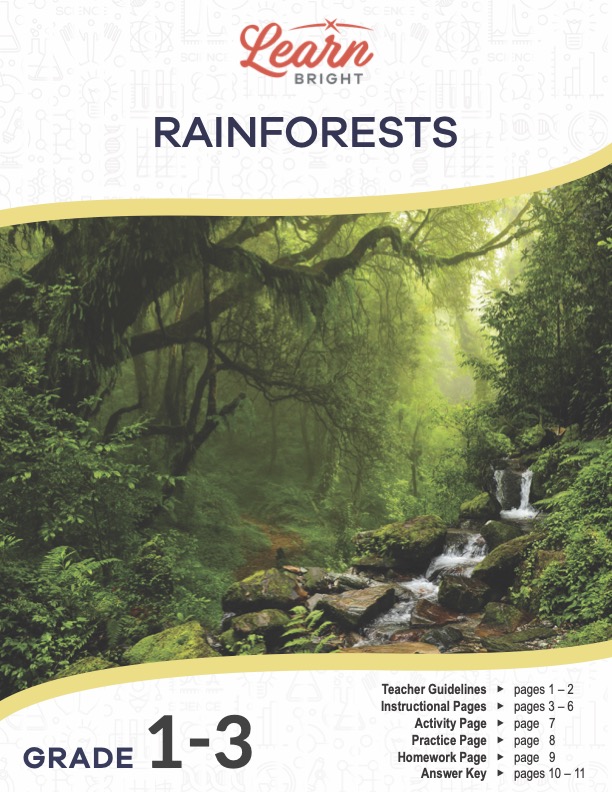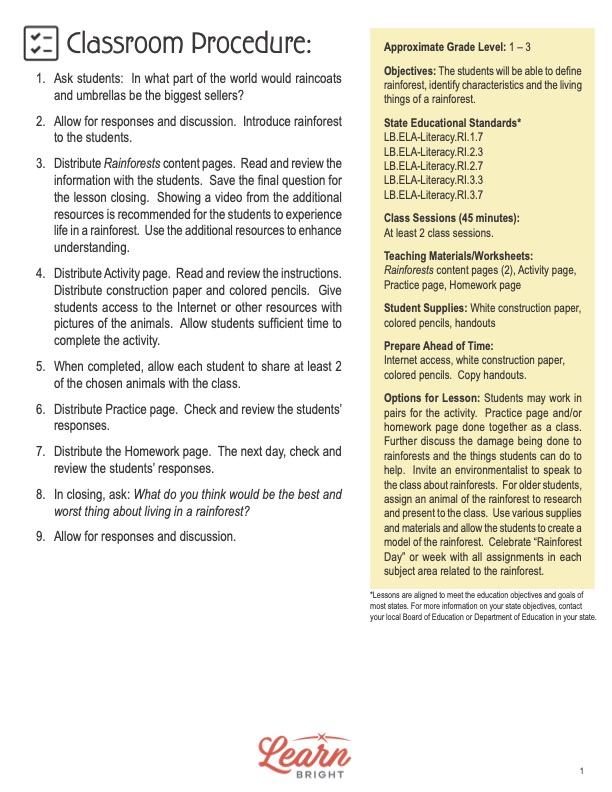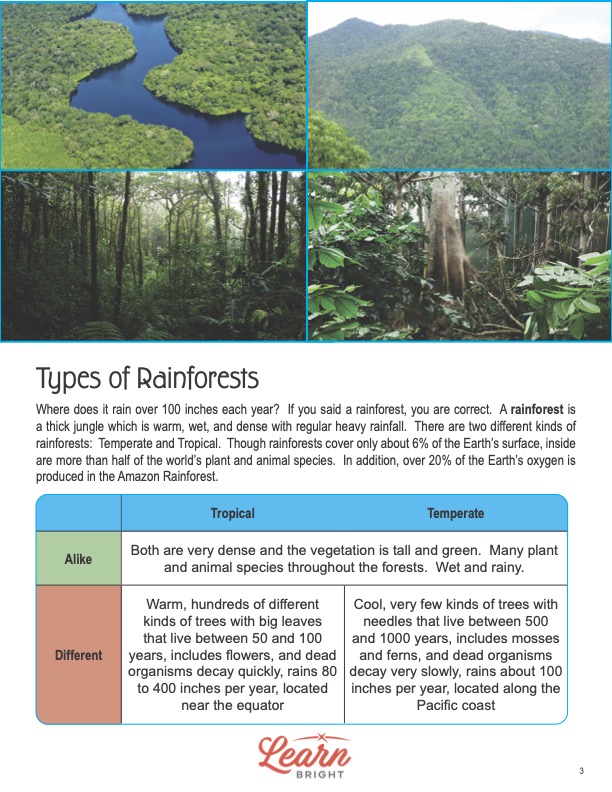Description
What our Rainforests lesson plan includes
Lesson Objectives and Overview: Rainforests explores the two types of this beautiful green habitat. Students will learn the features and characteristics of tropical and temperate rainforests and the animals that live there. The lesson is for students in 1st grade, 2nd grade, and 3rd grade.
Classroom Procedure
Every lesson plan provides you with a classroom procedure page that outlines a step-by-step guide to follow. You do not have to follow the guide exactly. The guide helps you organize the lesson and details when to hand out worksheets. It also lists information in the yellow box that you might find useful. You will find the lesson objectives, state standards, and number of class sessions the lesson should take to complete in this area. In addition, it describes the supplies you will need as well as what and how you need to prepare beforehand. The supplies this lesson requires are white construction paper and colored pencils, in addition to the handouts. You will also need to make sure students have access to the internet for part of the lesson.
Options for Lesson
In the “Options for Lesson” section of the classroom procedure page, you will find many ideas of additional activities or tasks or alternate ways to go about parts of the lesson. One idea is to consider completing the practice and/or homework worksheets together as a class. You could also take the opportunity to discuss the damage certain actions have on these environments. Another option is to invite an environmentalist to speak with the class. If you teach older students, you could assign them a rainforest animal to research and later present to the class. Another idea is to gather various supplies and materials for students to create models of a rainforest with. One last suggestion is to celebrate “Rainforest Day” (or week) and have all the assignments in each subject area relate to rainforests.
Teacher Notes
The paragraph on the teacher notes page gives you a little extra information about the lesson plan as you prepare. It encourages you to use videos to enhance students’ curiosity. You may also benefit from teaching this lesson in conjunction with others about different habitats, different forests, and so on. Use the blank lines to write down any other ideas you have before teaching the lesson to your students.
RAINFORESTS LESSON PLAN CONTENT PAGES
Two Types of Rainforests
The Rainforests lesson plan includes two content pages. Students will first receive a little background information on this kind of habitat in general. These regions get over 100 inches of rain every single year. They boast thick, green jungles that are generally warm, wet, and dense because of the heavy rainfall. There are two types of rainforests: temperate and tropical.
Rainforests cover only 6% of the surface of the Earth, but more than half of the world’s plant and animal species live in these areas. In other words, while it is not the largest habitat by far, it is home to the largest variety of animal and plant life. In addition, the Amazon rainforest alone produces 20% of the Earth’s supply of oxygen.
Students will then learn how tropical and temperate rainforests and similar and how they differ. Both are really dense, and they have tall green vegetation. Many kinds of plants and animals live throughout the forests. And finally, they are both very wet and very rainy.
Next, students will learn how the two types differ. Tropical rainforests, located near the equator, are warm and have hundreds of species of trees. The leaves are large and live between 50 and 100 years. The plant life includes many flowers, and dead organisms decay quickly. These forests also receive between 80 and 400 inches of rain each year.
Temperate rainforests, which are located along the Pacific coast, are on the cool side. There are much fewer species of trees, and their needles live between 500 and 1000 years! Mosses and ferns also grow in these regions, and dead organisms decay very slowly. The regions receive around 100 inches of rain per year.
Interesting Facts
Throughout the lesson, students will discover many different things about rainforests. For instance, these habitats exist all over the world, except in Antarctica. Many people think of Central America when they think of brightly colored birds. The largest rainforest in the world—the Amazon—is in South America. It contains a greater variety of plants and animals than any other place on Earth. The second largest is in Central Africa. The United States also has temperate rainforests that stretch from Northern California all the way up to Canada along the Pacific coastline.
There are four layers to a rainforest. Each layer has special and specific features and traits. The emergent layer is at the very top. Only the tallest trees, those that reach up to 200 feet, are a part of this layer. Usually, these are evergreen trees. Because they are at the top, they receive a lot of sunlight. The animals that live in the emergent layer include birds, butterflies, small monkeys, bats, snakes, and insects.
The next layer down is the canopy layer, which is like a roof over the lower layers. Most rain stops at this level, and most of the trees reach this height. Some of the plant’s roots don’t even reach the ground. Another name for these plants is air plants. Animals in this layer include monkeys, birds, frogs, sloths, lizards, snakes, and insects.
The understory layer of rainforests includes many vines and thick vegetation, and it receives very little light. Animals like frogs, snakes, butterflies, and birds live in the understory. The bottom layer is the forest floor. There are few living plants on the bottom. It is dark and damp and contains many dead and decaying organisms. The trees and plants above block most of the sunlight. Only 2% of the light reaches the forest floor. Which animals that live on the forest floor depends on the type of rainforest. They might include insects, jaguars, gorillas, leopards, tapirs, tigers, and elephants.
Animals of the Rainforest
The Rainforests lesson plan describes three specific animals that live in rainforest habitats: the spider monkey, toucan, and poison-arrow frog. The spider monkey is fairly large for a monkey, about two feet tall, that likes to hang upside down from tree branches with their four limbs and tail. They seem to resemble a spider and travel at very high speeds. Their diet consists of fruits and seeds from high up in the canopy layer. Sadly, they are currently in danger of becoming extinct.
Toucans are colorful birds with short but thick necks and very long bills. The bright colors on their bills help attract mates. The bill is also sharp enough to tear off pieces of fruit to eat. Toucans also eat lizards and small birds. They live in the holes in trees. In addition, they are quite important to their environment because they help scatter seeds.
Finally, students will learn about the poison tree frog. This frog’s poison is very powerful. In fact, it can paralyze and even cause death to the animals injected with it. A single frog has enough poison to kill 100 people! Native hunters in the area use the poison from these frogs to create their own poison arrows for weapons.
People and Food
Many groups of people have lived in the tropical rainforests for thousands of years. Many tribes obtain everything they need to survive from the habitat, including food, clothing, and shelter. The forest people are mostly hunter-gatherers who hunt for meat and fish and gather plants that they can eat.
Students will discover that, unfortunately, many of these indigenous groups have declining populations because of diseases like smallpox and measles, which are passed on to them by peoples outside the forests. Certain governments have taken some of the land the tribes live on. And parts have been destroyed by logging, mining, and slash-and-burn farmers.
Many delicious types of food come from rainforests, including pineapples, sugar, bamboo, bananas, coconuts, and cocoa. There is also coffee and tea and lots of spices, like ginger, pepper, cinnamon, vanilla, and paprika. People can also find rubber in these areas.
RAINFORESTS LESSON PLAN WORKSHEETS
The Rainforests lesson plan includes three worksheets: an activity worksheet, a practice worksheet, and a homework assignment. Each one will help students solidify their grasp of the lesson material and concepts. Use the guidelines on the classroom procedure page, which describe when to hand out each worksheet to the class.
SKETCH THE ANIMALS ACTIVITY WORKSHEET
The activity requires students to choose four animals from a list at the bottom of the worksheet. Students will sketch a drawing of each of the four animals they choose on a piece of construction paper. The worksheet shows them how to divide the paper. (Students can use the squares on the worksheet as a rough draft.) One drawing will go in each rectangle, along with the name of the animal and a fact about that animal. Students will share their work with the class once everyone finishes the task.
RAINFORESTS PRACTICE WORKSHEET
There are two sections on the practice worksheet. The first section requires students to write whether statements relate to tropical, temperate, or both rainforests. There are 15 statements total in this section. For the second section, students will describe which rainforest layer a statement represents. There are four statements in this section.
DEFINITIONS AND EXPLANATIONS HOMEWORK ASSIGNMENT
For the homework assignment, students will either define terms or answer questions that relate to the content. There are four terms to define. The next four questions ask students to name five animals that reside in each of the rainforest layers. The last three questions ask them about the three animals students learned about in the lesson.
Worksheet Answer Keys
The last two pages of the document are answer keys for the practice and homework worksheets. The answers are in red for both pages. For the most part, students responses should match those on the answer keys. However, there may be some variation on their animal lists and explanations on the homework assignment. If you choose to administer the lesson pages to your students via PDF, you will need to save a new file that omits these pages. Otherwise, you can simply print out the applicable pages and keep these as reference for yourself when grading assignments.










